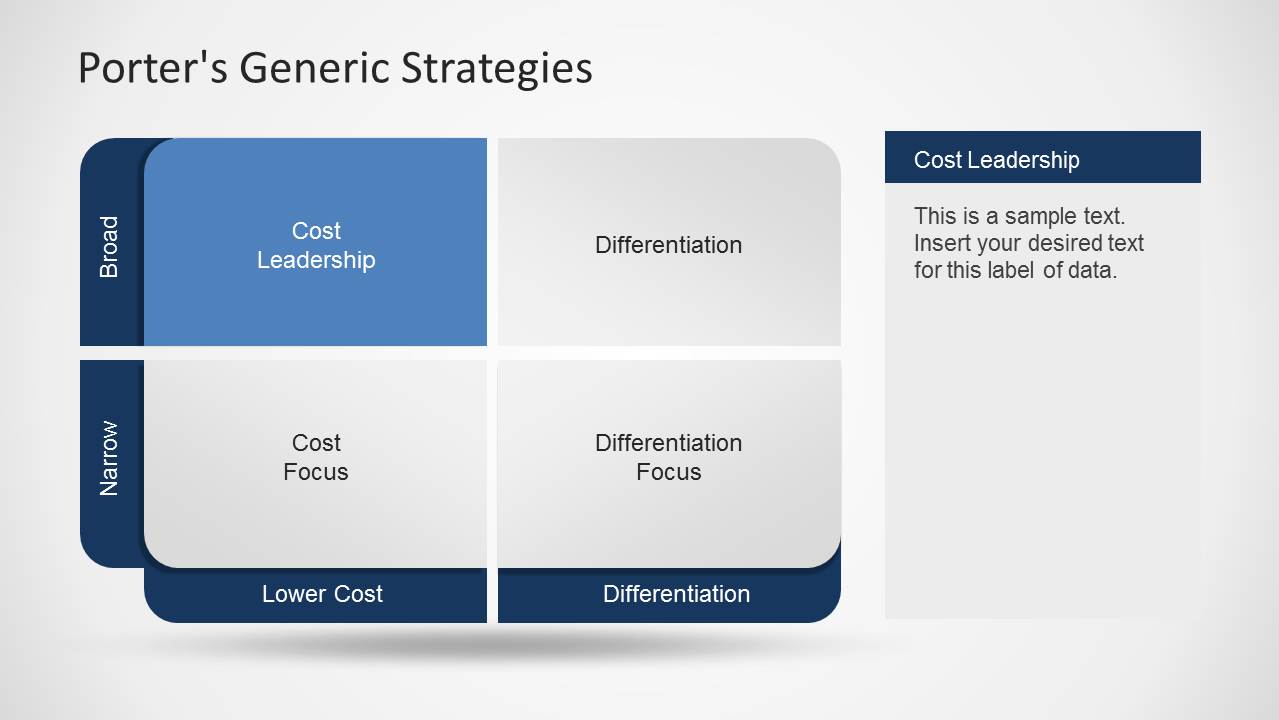It was the first amoxicillin (a type of antibiotic. We are all familiar with the framework that porter.

Porter's Generic Strategy PowerPoint Template SlideModel
According to porter, strategies allow organizations to gain competitive advantage from three different bases:

Porter's generic strategy framework. The competitive advantage of the company. Porter's generic strategies describe how a company pursues competitive advantage across its chosen market scope. This strategy framework explains how an organization obtains a competitive advantage across its premium target market scope.
According to porter, the previously mentioned factors combine to create four generic strategies that organisations can pursue. The four strategies to choose from are: The manipulation of cost can be done in two ways such as, 1.
The scope of the market targeted. Generic strategies were first presented in two books by professor michael porter of the harvard business school (porter, 1980, 1985). Lead to a stronger competitive advantage.
The strategies proposed depend on: Porter's generic strategies michael porter has described a category scheme consisting of three general types of strategies that are commonly used by businesses to achieve and maintain competitive advantage. Clamoxyl, the original amoxicillin antibiotic and one of sb’s ‘jewel’ drugs, was specifically targeted because its substitution by generic amoxicillins could save up to €26.
The generic strategies can be used to determine the direction (strategy) of your organisation. Porter’s generic strategies is an answer to one of two central questions underlying the choices companies have with regard to competitive strategy. Its usefulness for the description of other firms' strategies is unclear.
There are three/four generic strategies, either lower cost, differentiated, or focus.a company chooses to pursue one of two types of competitive advantage, either via lower costs than its competition or by differentiating itself along dimensions valued by customers to. Clamoxyl was no ordinary drug. This chapter concentrates on establishing.
Porter further classified focus in two approaches: 5 million for the french social security system, more than any other drug. They are your map as to how you are going to take your product to market, win customers and beat the competition.
Porter's generic strategies framework constitutes a major contribution to the development of the strategy development and strategic management literature in the modern world. Cost leadership strategy is a strategy to gain a competitive advantage by manipulating the cost of production. Probably the three most widely read books on competitive analysis in the 1980s were michael porter’s competitive strategy (1980), competitive advantage (1985), and competitive advantage of nations (1989).
Porter’s generic strategies are the standard basic strategies that a business can follow, suggested by michael porter. He believes that a company must choose a clear course in order to be able to beat the competition. Michael porter uses 4 strategies that an organisation can choose from.
Porter (1980, p.80) argues that “understanding the. Porter called the generic strategies cost leadership (no frills), differentiation (creating uniquely desirable products and services) and focus (offering a specialized service in a niche market). Porter demonstrated that pursuing a competitive generic strategy can.
The motor vehicle industry is used as an example in the analysis of these four strategies: Here we will deal with all these types of 4 generic strategies. Michael porter is a professor at harvard business school.
It is not suitable for an empirical description of multinational or diversified firms' strategies. The focus strategy has two variants. Furthermore, it is now generally accepted that.
The generic strategy of focus rests on the choice of a narrow competitive scope within an industry. Differentiation strategy is the strategy that lays emphasis on offering a superior product, on some dimension (s), compared to what competitors are providing. What makes the company “strong” in the market.
Cost leadership — where the organisation’s resources and. And understanding the five forces model and the generic strategies. Porter’ s five forc es.
The porter's framework is a useful tool for identifying new entrants into the market and the threats they may pose. It is comprised of three generic. Porter’s framework is shown in the diagram on the right.
Differentiation is possible along one or more of various dimensions — product features, quality, customer service, guarantee, distribution, delivery, product customization, etc. Cost focus and differentiation focus. In 1980 he wrote the book competitive strategy in which he described the three generic positions of differentiation, cost leadership and focus.
Porter’s generic strategy framework • the three strategies are: The porter's five forces analysis examines competitive rivalry and buyer bargaining power, which can have an impact on unilever's business operations. Cost focus and differentiation focus. these are shown in figure 1 below.
He then subdivided the focus strategy into two parts: (a) in cost focus a firm seeks a cost advantage in its target. Porter's generic strategies' framework is characterized by serious limitations from the perspective of both research methodology and managerial relevance.
The application of porter's generic framework. Strategic scope and strategic strength. The focuser selects a segment or group of segments in the industry and tailors its strategy to serving them to the exclusion of others.
These three generic strategies are defined along two dimensions: If the company is targeting the entire market or just a small. 1.cost leadership, 2.differentiation, and 3.market segmentation (or focus) • market segmentation is narrow in scope while both cost leadership and differentiation are relatively broad in market scope.
The purpose of this research is. So, in all, there are four strategies that a company can select from.